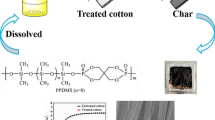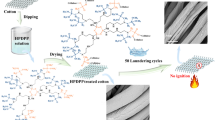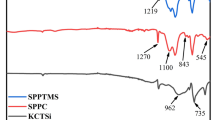Abstract
Cotton fabric has a wide application due to its hygroscopicity, air permeability, and large production of cotton fiber used to make the fabric. However, cotton materials are a safety hazard during its application because of flammability (limiting oxygen index is about 18%). In order to improve the flame retardancy of cotton fibers and reduce the damage of its mechanical properties, novel P/Si based flame retardant (PFR) nanoparticles were synthesized by one-step radical polymerization. Vinyl phosphoric acid and tetramethyl divinyl disiloxane were introduced into the nanoparticles. The structure, morphology and thermal stability of PFR was characterized by fourier transform infrared spectroscopy (FT-IR), field emission scanning electron microscopy (FE-SEM), thermogravimetric analysis test (TGA). Durable flame retardant cotton fibers were prepared by dip-coating and plasma induced crosslinking methods. Micro-calorimeter (MCC) characterization showed that the peak of heat release rate (pHRR) and the total heat release (THR) were reduced by 47.3% and 29.8% for modified cotton fibers compared with pure cotton fibers. Limiting oxygen index (LOI) of modified cotton fibers was increased to 27%. The residue carbon of modified cotton fibers was 19.0% at 700 °C, while the value of pure cotton fibers was 3.0%. Besides, durability of the modified cotton fibers was approved by cyclic washing test. In addition, flame retardant mechanism was revealed by collecting and analyzing condensed and gaseous pyrolysis products. The data of FE-SEM for residue carbon, FT-IR spectra of products at different pyrolysis temperatures and pyrolysis gas chromatography mass spectrometry (Py-GC–MS) showed that PFR was a synergistic flame retardant contained barrier and quenching effecting applied on cotton materials.
Graphical abstract
Novel phosphorus-silicon based nanoparticles were synthesized by one-step radical polymerization and applied to improve the flame retardant of cotton materials by dip-coating and plasma induced crosslinking.












Similar content being viewed by others

References
Alongi J et al (2011) Novel flame retardant finishing systems for cotton fabrics based on phosphorus-containing compounds and silica derived from sol-gel processes. Carbohydr Polym 85:599–608
Alongi J et al (2013) DNA: a novel, green, natural flame retardant and suppressant for cotton. J Mater Chem A 1:4779–4785
Alongi J et al (2014) Caseins and hydrophobins as novel green flame retardants for cotton fabrics. Polym Degrad Stab 99:111–117
Balabanovich AI et al (2009) Pyrolysis study of a phosphorus-containing aliphatic–aromatic polyester and its nanocomposites with layered silicates. Polym Degrad Stab 94:355–364
Bourbigot S et al (2004) Recent advances for intumescent polymers. Macromol Mater Eng 289:499–511
Cai W et al (2018) Bio-oil production from fast pyrolysis of rice husk in a commercial-scale plant with a downdraft circulating fluidized bed reactor. Fuel Process Technol 171:308–317
Camino G et al (2001) Intumescent materials. Fire retardant mater 1:318–336
Cheema HA et al (2013) Conferring flame retardancy on cotton using novel halogen-free flame retardant bifunctional monomers: synthesis, characterizations and applications. Carbohydr Polym 92:885–893
Chen SS et al (2015) Intumescent flame-retardant and self-Healing superhydrophobic coatings on cotton fabric. ACS Nano 9:4070–4076
Chu F et al (2018) A facile strategy to simultaneously improve the mechanical and fire safety properties of ramie fabric reinforced unsaturated polyester resin composites. Compos Part A 115:264–273
Edwards B et al (2012) Towards flame retardant cotton fabrics by atmospheric pressure plasma-induced graft polymerization: Synthesis and application of novel phosphoramidate monomers. Surf Coat Tech 209:73–79
Guo WW et al (2020) Construction of durable flame-retardant and robust superhydrophobic coatings on cotton fabrics for water-oil separation application. Chem. Eng. J. 398:125661
Han H et al (2019) Inherent guanidine nanogels with durable antibacterial and bacterially antiadhesive properties. Adv Funct Mater 29:1806594
He C et al (2018) Mechanically resistant and sustainable cellulose-based composite aerogels with excellent flame retardant, sound-absorption, and superantiwetting ability for advanced engineering materials. ACS Sustain Chem Eng 6:927–936
Hong N et al (2013) Facile preparation of graphene supported Co3O4 and NiO for reducing fire hazards of polyamide 6 composites. Mater Chem Phys 142:531–538
Horrocks AR et al (2012) Zinc stannate interactions with flame retardants in polyamides; part 2: potential synergies with non-halogen-containing flame retardants in polyamide 6 (PA6). Polym Degrad Stab 97:645–652
Hou YB et al (2018) DOPO-Modified twodimensional Co-based metal-organic framework: preparation and application for enhancing fire safety of poly (lactic acid). ACS Appl Mater Interf 10:8274–8286
Indraneel SZ et al (2017) Development and evaluation of a water-based flame retardant spray coating for cotton fabrics. ACS Appl Mater Interf 9:40782–40791
Jian L et al (2020) Multifunctional flame retarded and hydrophobic cotton fabrics modified with a cyclic phosphorus/polysiloxane copolymer. Cellulose 27:3531–3549
Jiang SD et al (2018) Biobased polyelectrolyte multilayer-coated hollow mesoporous silica as a green flame retardant for epoxy resin. J Hazard Mater 342:689–697
Kim MJ et al (2014) Graphene phosphonic acid as an efficient flame retardant. ACS Nano 8:2820–2825
Lazar ST et al (2020) Flame-retardant surface treatments. Nat Rev Mater 5:259–275
Li YC et al (2011) Intumescent all-polymer multilayer nanocoating capable of extinguishing flame on fabric. Adv Mater 23:3926–3931
Li P et al (2019a) Ecofriendly flame retardant cotton fabrics: preparation, flame retardancy, thermal degradation properties, and mechanism. ACS Sustain Chem Eng 7:19246–19256
Li N et al (2019b) Novel eco-friendly flame retardants based on nitrogen-silicone schiff base and application in cellulose. ACS Sustain Chem Eng 8:290–301
Li N et al (2021) Eco-friendly and intrinsic nanogels for durable flame retardant and antibacterial properties. Chem. Eng. J. 415:129008
Malshe P (2012) Functional military textile: plasma-induced graft polymerization of DADMAC for antimicrobial treatment on nylon-cotton blend fabric. Plasma Chem Plasma Process. 32(4):833–43
Mathangadeera RW et al (2020) Importance of cotton fiber elongation in fiber processing. Ind. Crop. Prod. 147:112217
Nechyporchuk O et al (2017) Wet spinning of flame-retardant cellulosic fibers supported by interfacial complexation of cellulose nanofibrils with silica nanoparticles. ACS Appl Mater Interf 9:39069–39077
Pan Y et al (2017) Influences of metal ions crosslinked alginate based coatings on thermal stability and fire resistance of cotton fabrics. Carbohydr Polym 170:133–139
Pastorova I et al (1993) Preservation of d-glucose-oligosaccharides in cellulose chars. Carbohydr Res 248:151–165
Pethsangave DA et al (2019) Novel approach toward the synthesis of a phosphorus-functionalized polymer-based graphene composite as an efficient flame retardant, ACS Sustain. Chem Eng 7:11745–11753
Qu H et al (2011) Thermal degradation and fire performance of wood treated with various inorganic salts. Fire Mater 35:569–576
Rabe S et al (2017) Exploring the modes of action of phosphorusbased flame retardants in polymeric systems. Materials 10:455
Rao WH et al (2021) Highly efficient, transparent, and environment-friendly flame-retardant coating for cotton fabric. Chem. Eng. J. 28:130556
Schartel B et al (2016) Flame retardancy of polymers: the role of specific reactions in the condensed phase. Macromol Mater Eng 301:9–35
Schumacher DQ et al (2020) Industrial hemp fiber: A sustainable and economical alternative to cotton. J. Clean. Prod. 268:122180
Shahidi SL (2014) Novel method for ultraviolet protection and flame retardancy of cotton fabrics by low-temperature plasma. Cellulose 21:757–768
Sun L et al (2021) A novel P/N-based flame retardant synthesized by one-step method toward cotton materials and its flame-retardant mechanism. Cellulose 28:3249–3264
Tsafack MJ et al (2008) Flame retardancy of cotton textiles by plasma-induced graft-polymerization (PIGP). Surf Coat Tech 201:2599–2610
Velencoso MM et al (2018) Molecular Firefighting-How modern phosphorus chemistry can help solve the challenge of flame retardancy. Angew Chem Int Ed Engl 57:10450–10467
Wang J et al (2018) Construction of multifunctional MoSe2 hybrid towards the simultaneous improvements in fire safety and mechanical property of polymer. J Hazard Mater 352:36–46
Wang SH et al (2020) Surface coated rigid polyurethane foam with durable flame retardancy and improved mechanical property. Chem. Eng. J. 385:123755
Wicklein B et al (2015) Thermally insulating and fire-retardant lightweight anisotropic foams based on nanocellulose and graphene oxide. Nat Nanotechnol 10:277–283
Wu J et al (2018) New application for aromatic Schiff base: high efficient flame-retardant and anti-dripping action for polyesters. Chem Eng J 336:622–632
Yang G et al (2019) Synthesis of a novel phosphazene-based flame retardant with active amine groups and its application in reducing the fire hazard of Epoxy Resin. Hazard Mater 366:78–87
Zhang AN et al (2021) Construction of durable eco-friendly biomass-based flame-retardant coating for cotton fabrics. Chem. Eng. J. 410:128361
Zhu L et al (2016) The interactions among the pyrolysis of biomass components based on the PY-GC/MS. Chem Ind Eng Prog 35:3879–3884
Zope IS et al (2017) Development and evaluation of a water-based flame retardant spray coating for cotton fabrics. ACS Appl Mater Inter 9:40782–40791
Acknowledgements
The research is supported by the National Key Research and Development Program of China (Project Number 2017YFB0309001), the Natural Science Foundation of Shanghai (18ZR1400400, 18ZR1400500, 20ZR1402100), and the Fundamental Research Funds for the Central Universities and Graduate Student Innovation Fund of Donghua University (CUSF-DHD-2019049).
Author information
Authors and Affiliations
Corresponding authors
Ethics declarations
Conflict of interest
The authors declare that they have no conflict of interest. This article does not contain any studies with human participants or animals performed by any of the authors. Informed consent has been obtained from all individual participants included in the study.
Additional information
Publisher's Note
Springer Nature remains neutral with regard to jurisdictional claims in published maps and institutional affiliations.
Supplementary Information
Below is the link to the electronic supplementary material.
Rights and permissions
About this article
Cite this article
Li, N., Chen, P., Liu, D. et al. Novel P/Si based nanoparticles for durable flame retardant application on cotton. Cellulose 29, 2063–2076 (2022). https://doi.org/10.1007/s10570-021-04309-4
Received:
Accepted:
Published:
Issue Date:
DOI: https://doi.org/10.1007/s10570-021-04309-4



